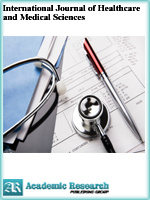International Journal of Healthcare and Medical Sciences
Online ISSN: 2414-2999
Print ISSN: 2415-5233
Print ISSN: 2415-5233
Quarterly Published (4 Issues Per Year)

Archives
Volume 9 Number 1 March 2023
Castleman Disease and Literature Review from Mankweng Hospital, Limpopo, South Africa
Authors: Cassius Tumelo Makgabo Mathopa ; Mirza Mohamod Zahir Uddin Bhuiyan
Pages: 12-16
DOI: doi.org/10.32861/ijhms.91.12.16
Abstract
Castleman disease is a lymphoproliferative disorder and is easily confused with lymphoma or other lymphadenopathy. Castleman’s disease is divided into unicentric Castleman disease, which involved a single enlarged lymph node or region of lymph nodes, and multicentric Castleman disease, which involved multiple lymph node stations. In this paper we highlight the presentation of Castleman’s disease on a female patient to share our experience with literature review. Case Presentation: A 29 years old female patient was referred to our surgical outpatient clinic from the peripheral hospital with right & left painless neck cervical mass slowly growing which started 3 years ago along with a right breast lump and patient was RVD non-reactive. On physical examination she was severely wasted. She had a 4cm by 3cm mass of the right supraclavicular region & another mass of 3cm x 1 cm mass on the left supraclavicular area. Her abdominal examination revealed hepatomegaly which is extended 8 cm below the subcostal margin. Histology report of cervical mass concluded Reactive lymph nodes with features of hyaline vascular Castleman disease and Breast mass revealed fibroadenoma. Immunohistochemistry of cervical node biopsy for HHV8 is negative. Blood result of inflammatory markers: C - reactive protein was 459 mg/L. Conclusions: Owing to the rarity of this condition, Castleman Disease Collaborative Network (CDCN) guideline is important for assessment & treatment plan.
Knowledge and Practice of Breast Self Examination as Early Detection Method of Breast Cancer and Associated Factors Among Wolkite Univeresity Female Students, Southern Ethiopia
Authors: Kebebush Zepre ; Muluken Mussie ; Alazar Gebremeskel ; Asegedech wondimu
Pages: 1-11
DOI: doi.org/10.32861/ijhms.91.1.11
Abstract
Background: Breast cancer is the most frequently diagnosed and common cause of cancer death globally. Currently it is highly prevalent among women in Ethiopia. Breast cancer is fatal due to late presentation, limited resources, and lack of awareness of breast cancer early detection methods. Objective: This study is aimed to assess knowledge and practice of breast self-examination as an early detection method of breast malignancy and associated factors among female students at Wolkite University, southern Ethiopia. Methods: An institution-based survey was conducted among 382 randomly selected female students in Wolkite University, Southern Ethiopia. The collected data were summarized and presented in a table and figure. Binary logistic regression (backward stepwise regression) model was fitted with Breast self-examination knowledge and practice and factor variables. Result: In this study the response rate was 100%. About 116(40.3%) female students had good Knowledge on Breast self-examination. While, 50(26.6%) had practiced breast self-examination. Respondents in the age range of 22-25 years (AOR=2.7; 95% CI; 1.21, 5.94), who grew up in rural areas (AOR=.47; 95% CI; .22, .99) and respondents who have got information from school (AOR=.22;95% CI;.10, .48) were predictors of breast self-examination knowledge, while respondents in the age range of 22-25 years (AOR=.02; 95% CI; .01, .22) and ≥ 26 years (AOR=.04; 95% CI; .002, .74), who are protestant in religion (AOR=5.9; 95% CI; 1.52, 23.28), who grew up in the urban area (AOR=3.26; 95% CI; 1.17, 9.05) and who have good knowledge on BSE (AOR=26.33% CI; 8.58, 80.80,) were predictors of breast self-examination practice. Conclusion: Breast self-examination knowledge and practice are vital to detect breast cancer early and take the necessary measure. age, years of study, source of information, and place of grew up are major predictors of BSE knowledge and age, religion, place of grew up and knowledge of breast self-examination were major BSE predictors.



